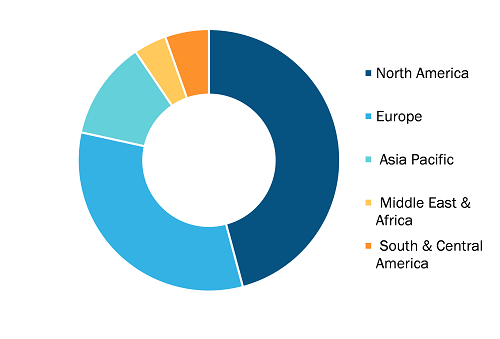
Digital Health Market
The digital health market, based on geography, is segmented into North America (the US, Canada, and Mexico), Europe (Germany, France, Italy, the UK, Spain, and the Rest of Europe), Asia Pacific (Australia, China, Japan, India, South Korea, and the Rest of Asia Pacific), Middle East & Africa (South Africa, Saudi Arabia, the UAE, and Rest of Middle East & Africa), and South & Central America (Brazil, Argentina, and the Rest of South & Central America).
North America held the largest share of the global market in 2022. The transformation of digital healthcare and the increasing adoption of smart healthcare solutions, including various technologies such as mobile apps, smart wearables, and eHealth services such as EHR and telemedicine services, which allow remote patient monitoring, majorly drive the market. Other factors such as the introduction of advanced software technologies in healthcare, a higher number of hospitals, and the implementation of strategic government policies also aid in promoting the digital health market. The US is the largest contributor to the digital health market in North America.
Additionally, Asia Pacific is expected to register the highest CAGR from 2022 to 2030, primarily due to the advancements in technology and healthcare services, as well as changes in the regulatory policies of the region. Additionally, governments of countries such as Japan, China, and India are taking initiatives to encourage digital healthcare solutions. This is anticipated to boost the growth of the digital health market in the region.

Digital health encompasses various technologies and practices related to healthcare. This includes eHealth, which involves using electronic means for monitoring patients, conducting consultations, managing electronic health records, and other similar activities. Digital health also includes emerging technologies such as artificial intelligence, Big Data, and genomics. The growing availability of mobile devices and internet connectivity presents an excellent opportunity to utilize digital health solutions, even in areas with limited resources. As per the article published by MDPI in 2023, more than 80% of the population in developing countries own a mobile phone, and almost half of the world’s population uses the Internet. This widespread access to digital platforms highlights the potential impact of digital health interventions.
Additionally, with the increase in the usage of tablets and smartphones, there has been a shift toward wearables and other healthcare applications. As a result, companies are developing numerous health applications to cater to the demand. For instance, as per a report released by IQVIA Institute for Human Data Science on Digital Health Trends in July 2021, over 90,000 new consumer health apps were launched in 2020, bringing the total number of available apps to over 350,000. These apps increasingly focus on helping consumers manage their health conditions instead of just wellness management. Consumer illness management applications accounted for 47% of the most popular digital health apps in 2020, compared to 28% in 2015.
Digital Health Market: Segmental Overview
The digital health market is segmented based on offering, technology, application, end user, and geography. The digital health market, by offering, is segmented into software, services, and hardware. The services segment held the largest market share in 2022 and is anticipated to register the highest CAGR during 2022–2030.
The digital health market, by technology, is segmented into mHealth, tele-healthcare, digital health systems, and others. The mHealth segment held the largest market share in 2022. The tele-healthcare segment will grow fastest from 2022 to 2030.
The digital health market, by application, is segmented into chronic disease management, behavioral health, health and fitness, and others. In 2022, the chronic disease management segment held the largest market share.
The digital health market, by end user, is segmented into hospitals & clinics, patients & consumers, and others. In 2022, the hospitals & clinics segment held the largest market share.
Digital Health Market: Competitive Landscape and Key Developments
Cerner Corporation; eClinicalWorks; Allscripts Healthcare Solutions Inc.; Honeywell International Inc.; Cisco Systems; GE HealthCare; Koninklijke Philips N.V.; Siemens Healthineers AG; Qualcomm Technologies, Inc.; and Fitbit, Inc. are the major players profiled in the report. The companies have been implementing various strategies that contributed to their growth and led to various changes in the market. The companies utilize organic strategies such as launches, expansions, and product approvals and inorganic strategies such as collaborations and partnerships.
A few of the key developments by major market players are as follows:
- In June 2021, Amazon launched a digital health accelerator, AWS Healthcare Accelerator, to support startups in healthcare’s virtual care and analytics sectors. The program prioritizes remote patient monitoring, data analytics, patient engagement, voice technology, and virtual care.
- In October 2021, Deloitte and Vodafone announced a strategic alliance to enable greater access to healthcare across Europe through the Vodafone Centre for Health with Deloitte. This collaboration aimed at speeding up the adoption of connected healthcare. This virtual center unites Vodafone’s connected health solutions with Deloitte’s healthcare consulting expertise to make healthcare more accessible for individuals, regardless of when and where they require it.







